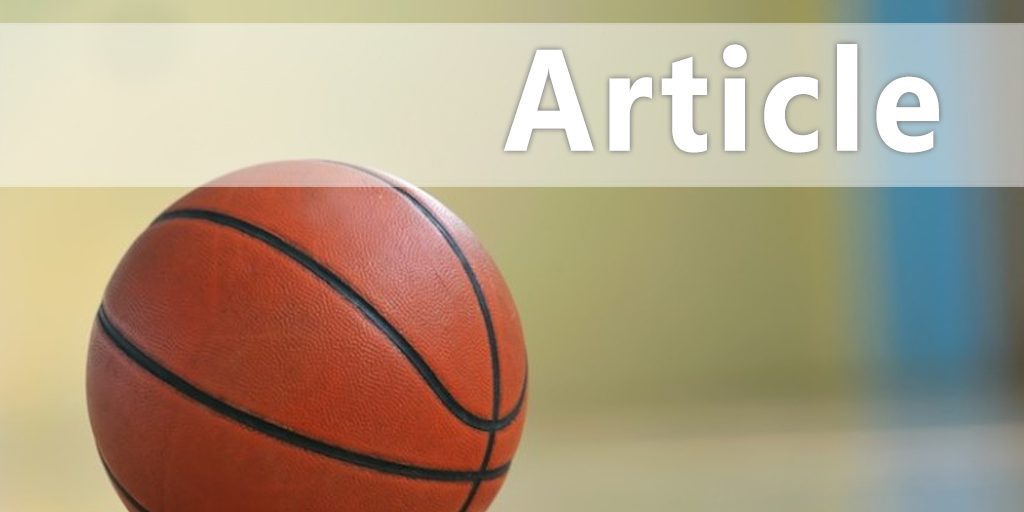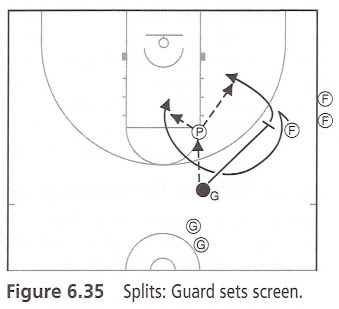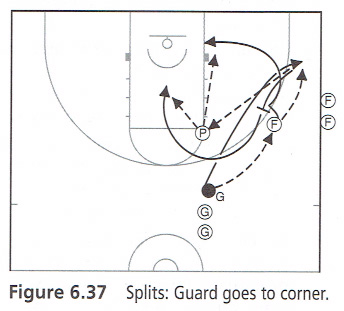| Three Player Screening Drills |
| By: Lee Rose
Originally Published in: Winning Basketball Fundamentals Provided by: Human Kinetics 1. The screener must know the distance restrictions for front, side, and back screens as they apply to the defender being screened. 2. The screener cannot move or lean to cause contact. 3. Proper body position has the feet spread shoulder-width apart, arms and elbows in (not extended), and the body upright. All effective half-court offenses depend on proper screening techniques to avoid committing offensive fouls. Nothing hurts a team more than holding for a last shot at the end of the game and then having a player set an illegal screen to forfeit the opportunity to win. Here are four excellent three-player drills that can build a stronger basketball foundation. SPLITS: GUARD SETS SCREEN Focus Three-player drill-screening, passing, and shooting. Procedure Players begin on the half court and follow these steps: 1. On the right side, a guard (G) with the ball lines up 6 feet (2 m) beyond the top of the key, directly in line with the elbow. 2. A forward (F) lines up 3 feet (1 m) inside the sideline boundary, even with the free-throw line extended. 3. The guard makes a direct pass to the post (P) and sets a screen for the for-ward. 4. To set up the defender, the forward uses a jab step to the baseline and cuts to the middle off the screen set by the guard, looking for a pass from the post. This action is commonly known as split action or scissors. 5. In setting the pick, the guard must stop and hold the screen until the forward clears the contact area (to avoid committing a moving screen, which results in an offensive foul). The guard continues to the baseline, looking for a return pass from the post and the opportunity to score. 6. The post decides who shoots the ball. He can pass either to the forward cutting down the middle or the guard on the baseline (figure 6.35). The third option is to let both teammates clear the area and then make an individual move. 7. Whoever doesn't shoot becomes the rebounder, and the players return to their respective lines. SPLITS: GUARD REVERSES Focus Three-player drill-screening, passing, and shooting. Procedure Players begin on the half court and follow these steps: 1. On the right side, a guard with the ball (G) lines up 6 feet (2 m) beyond the top of the key, directly in line with the elbow. 2. A forward (F) lines up 3 feet (1 m) inside the sideline boundary, even with the free-throw line extended. 3. The guard makes a bounce pass to the forward, goes behind him, and receives the hand off. 4. The guard makes one or two quick dribbles, stops, executes a left-foot reverse (that is, the left foot is the pivot foot), and passes to the post (P) at the mid-post area. The guard then sets a screen on the forward's defender and cuts to the middle, looking for a return pass and the shot. 5. After the forward hands off the ball to the guard, the forward takes two steps away from the guard. After the ball goes into the post, the forward cuts baseline off the guard's screen, looking for the ball and a shot. 6. The post decides who will shoot the ball and passes either to the forward on the baseline or to the guard cutting down the middle (figure 6.36). The third option is to let both teammates clear the area and then make an individual move. 7. Whoever doesn't shoot becomes the rebounder, and the players return to their respective lines. SPLITS: GUARD GOES TO CORNER Focus Three-player drill-screening, passing, and shooting. Procedure Players begin on the half court and follow these steps: 1. On the right side, a guard (G) with the ball lines up 6 feet (2 m) beyond the top of the key, directly in line with the elbow. 2. A forward (F) lines up 3 feet (1 m) inside the sideline boundary, even with the free-throw line extended. 3. The guard makes a chest pass to the forward and goes to the ball-side short corner. 4. The forward passes to the guard and takes a couple of steps toward the middle to create space and provide a better passing angle for the guard. 5. The guard then passes to the post (P) and sets a screen for the forward. After the ball goes to the post, the forward uses a jab step and cuts baseline off the guard's screen, looking for a pass and a shot. 6. The post decides who will shoot the ball and can pass either to the forward on the baseline or to the guard cutting down the middle (figure 6.37). The third option is to let both teammates clear the area and then make an individual move. 7. Whoever doesn't shoot the ball becomes the rebounder, and the players return to their respective lines. |









